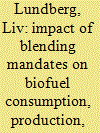| Srl | Item |
| 1 |
ID:
094213


|
|
|
|
|
| Publication |
2010.
|
| Summary/Abstract |
This paper provides a forecast of electricity consumption in Cyprus up to the year 2030, based on econometric analysis of energy use as a function of macroeconomic variables, prices and weather conditions. If past trends continue electricity use is expected to triple in the coming 20-25 years, with the residential and commercial sectors increasing their already high shares in total consumption. Besides this reference scenario it was attempted to assess the impact of climate change on electricity use. According to official projections, the average temperature in the Eastern Mediterranean is expected to rise by about 1 °C by the year 2030. Using our econometrically estimated model, we calculated that electricity consumption in Cyprus may be about 2.9% higher in 2030 than in the reference scenario. This might lead to a welfare loss of 15 million Euros in 2020 and 45 million Euros in 2030; for the entire period 2008-2030 the present value of costs may exceed 200 million Euros (all expressed in constant Euros of 2007). Moreover, we assessed the additional peak electricity load requirements in the future because of climate change: extra load may amount to 65-75 Megawatts (MW) in the year 2020 and 85-95 MW in 2030.
|
|
|
|
|
|
|
|
|
|
|
|
|
|
|
|
| 2 |
ID:
192774


|
|
|
|
|
| Summary/Abstract |
The transport sector accounts for about 20% of EU's GHG-emissions. Progress in emission reductions has been slow and primarily driven by biofuels promoted through national blending mandates. The mandates differ in whether they are measured in volume, energy, or emission reduction and in how gasoline and diesel are targeted. Due to this, national mandates and their effects have not previously been quantitatively compared on an EU level. In this article we convert the mandates for all EU member states between 2009 and 2020 to a common unit and study their impact on biofuel consumption, production, emission reductions and fuel prices. We find that mandates are driving biofuel consumption in the EU and correlates with emission reductions. Increased mandates have however often been fulfilled by blending biofuels eligible for double counting. We also find that reduction mandates have been effective in encouraging high-performance biofuels. For historical fuel prices, we do not see a clear correlation between countries' shares of biofuel and consumer fuel prices while the global oil price has a considerable impact. For biofuel production, increased demand drive investments in the EU, but when it comes to localisation of new plants factors such as local infrastructure are more important than national mandates.
|
|
|
|
|
|
|
|
|
|
|
|
|
|
|
|
| 3 |
ID:
096716


|
|
|
|
|
| Publication |
2010.
|
| Summary/Abstract |
Our objective in this paper is to quantify the impact of petroleum industry consolidation on refined product prices, controlling for other important factors that could also impact prices. Our empirical analysis focuses on the US petroleum refining industry using data on industry consolidation and wholesale gasoline prices collected over the interval 2000-2008. We match refinery units to wholesale city-terminal gasoline markets, and then estimate pooled cross-section time-series regressions to quantify the impact of petroleum industry consolidation on wholesale gasoline prices at city-specific terminals. The results of the empirical analysis of mergers are mixed, showing that some petroleum industry mergers resulted in statistically significant increases in refined product prices; others resulted in statistically significant declines and still others had no statistical impact at all. Our analysis of the effects of measures of market concentration-one at the level of city-specific wholesale terminals and another at the level of regional spot markets-found evidence that less concentrated markets are associated with lower price levels.
|
|
|
|
|
|
|
|
|
|
|
|
|
|
|
|
| 4 |
ID:
097509


|
|
|
|
|
| Publication |
2010.
|
| Summary/Abstract |
Our objective in this paper is to quantify the impact of petroleum industry consolidation on refined product prices, controlling for other important factors that could also impact prices. Our empirical analysis focuses on the US petroleum refining industry using data on industry consolidation and wholesale gasoline prices collected over the interval 2000-2008. We match refinery units to wholesale city-terminal gasoline markets, and then estimate pooled cross-section time-series regressions to quantify the impact of petroleum industry consolidation on wholesale gasoline prices at city-specific terminals. The results of the empirical analysis of mergers are mixed, showing that some petroleum industry mergers resulted in statistically significant increases in refined product prices; others resulted in statistically significant declines and still others had no statistical impact at all. Our analysis of the effects of measures of market concentration-one at the level of city-specific wholesale terminals and another at the level of regional spot markets-found evidence that less concentrated markets are associated with lower price levels.
|
|
|
|
|
|
|
|
|
|
|
|
|
|
|
|